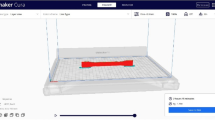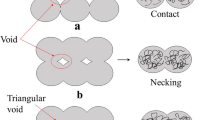Abstract
This experimental study investigates the effect of filling pattern on tensile and flexural strength and modulus of the parts printed via fused deposition modeling (FDM), 3D printer. The main downside of the printed products, with an FDM 3D printer, is the low strength compared to the conventional processes such as injection molding and machining. The issue stems from the low strength of thermoplastic materials and the weak bonding between deposited rasters and layers. Selection of proper filling pattern and infill percentage could highly influence the final mechanical properties of the printed products that were experimentally explored in this research work. Concentric, rectilinear, hilbert curve, and honeycomb patterns and filling percentage of 20, 50 and 100 were the variable parameters to print the parts. The results indicate that concentric pattern yields the most desirable tensile and flexural tensile properties, at all filling percentages, apparently due to the alignment of deposited rasters with the loading direction. Hilbert curve pattern also yielded a dramatic increase in the properties, at 100% filling. The dramatic increase could be mainly attributed to the promotion of strong bonding between the rasters and layers, caused by maintaining a high temperature of rasters at short travelling distances of nozzle for the hilbert curve pattern. Scanning electron microscopy (SEM) examination revealed the strong bonding between rasters and sound microstructures (less flaws and voids) for concentric and hilbert curve pattern at a high filling percentage of 100. Besides, SEM examination revealed large voids in honeycomb pattern, deemed to be responsible for its lower strength and modulus, especially at the filling percentage of 100.




















Similar content being viewed by others
References
Shaffer S, Yang K, Vargas J, Di Prima MA, Voit W (2014) On reducing anisotropy in 3D printed polymers via ionizing radiation. Polymer 55(23):5969–5979
Guo N, Leu MC (2013) Additive manufacturing: technology, applications and research needs. Front Mech Eng 8(3):215–243
Mostafa N, Syed HM, Igor S, Andrew G (2009) A study of melt flow analysis of an ABS-iron composite in fused deposition modelling process. Tsinghua Sci Technol 14:29–37
Goyanes A, Buanz AB, Basit AW, Gaisford S (2014) Fused-filament 3D printing (3DP) for fabrication of tablets. Int J Pharm 476(1):88–92
Mannoor MS, Jiang Z, James T, Kong YL, Malatesta KA, Soboyejo WO, Verma N, Gracias DH, McAlpine MC (2013) 3D printed bionic ears. Nano Lett 13(6):2634–2639
Li D, Feng X, Liao P, Ni H, Zhou Y, Huang M, Li Z, Zhu Y (2014) 3D reverse modeling and rapid prototyping of complete denture. Frontier and Future Development of Information Technology in Medicine and Education. Springer: 1919–1927
Hudson SE (2014) Printing teddy bears: a technique for 3D printing of soft interactive objects. Proceedings of the SIGCHI Conference on Human Factors in Computing Systems. ACM, pp 459–468
Serizawa R, Shitara M, Gong J, Makino M, Kabir MH, Furukawa H (2014) 3D jet printer of edible gels for food creation. Proceedings of SPIE Smart Structures and Materials Nondestructive Evaluation and Health Monitoring:90580A-90580A
Akhoundi B, Behravesh AH, Bagheri Saed A (2018) Improving mechanical properties of continuous fiber-reinforced thermoplastic composites produced by FDM 3D printer. J Reinf Plast Compos. https://doi.org/10.1177/0731684418807300
Bellehumeur C, Li L, Sun Q, Gu P (2004) Modeling of bond formation between polymer filaments in the fused deposition modeling process. J Manuf Process 6(2):170–178
Sun Q, Rizvi G, Bellehumeur C, Gu P (2008) Effect of processing conditions on the bonding quality of FDM polymer filaments. Rapid Prototyp J 14(2):72–80
Ahn S-H, Montero M, Odell D, Roundy S, Wright PK (2002) Anisotropic material properties of fused deposition modeling ABS. Rapid Prototyp J 8(4):248–257
Panda SK, Padhee S, Anoop Kumar S, Mahapatra S (2009) Optimization of fused deposition modelling (FDM) process parameters using bacterial foraging technique. Intell Inf Manag 1(02):89
Rayegani F, Onwubolu G (2014) Fused deposition modelling (FDM) process parameter prediction and optimization using group method for data handling (GMDH) and differential evolution (DE). Int J Adv Manuf Technol 73
Tymrak B, Kreiger M, Pearce JM (2014) Mechanical properties of components fabricated with open-source 3-D printers under realistic environmental conditions. Mater Des 58:242–246
Melenka GW, Schofield JS, Dawson MR, Carey JP (2015) Evaluation of dimensional accuracy and material properties of the MakerBot 3D desktop printer. Rapid Prototyp J 21(5):618–627
Torres J, Cotelo J, Karl J, Gordon AP (2015) Mechanical property optimization of FDM PLA in shear with multiple objectives. Jom 67(5):1183–1193
Baich L, Manogharan G, Marie H (2015) Study of infill print design on production cost-time of 3D printed ABS parts. Int J Rapid Manuf 5(3–4):308–319
Fernandez-Vicente M, Calle W, Ferrandiz S, Conejero A (2016) Effect of infill parameters on tensile mechanical behavior in desktop 3D printing. 3D Print Add Manufact 3(3):183–192
Dawoud M, Taha I, Ebeid SJ (2016) Mechanical behaviour of ABS: an experimental study using FDM and injection moulding techniques. J Manuf Process 21:39–45
Wang J, Xie H, Weng Z, Senthil T, Wu L (2016) A novel approach to improve mechanical properties of parts fabricated by fused deposition modeling. Mater Des 105:152–159
Mohamed OA, Masood SH, Bhowmik JL (2017) Experimental investigation of time-dependent mechanical properties of PC-ABS prototypes processed by FDM additive manufacturing process. Mater Lett 193:58–62
Holman JP (2001) Heat transfer, eighth SI metric edition. Mc Gran–Hill Book Company
Farah S, Anderson DG, Langer R (2016) Physical and mechanical properties of PLA, and their functions in widespread applications—a comprehensive review. Adv Drug Deliv Rev 107:367–392
Author information
Authors and Affiliations
Corresponding author
Ethics declarations
Conflict of Interest
The authors declare that they have no conflict of interest.
Additional information
Publisher’s Note
Springer Nature remains neutral with regard to jurisdictional claims in published maps and institutional affiliations.
Rights and permissions
About this article
Cite this article
Akhoundi, B., Behravesh, A.H. Effect of Filling Pattern on the Tensile and Flexural Mechanical Properties of FDM 3D Printed Products. Exp Mech 59, 883–897 (2019). https://doi.org/10.1007/s11340-018-00467-y
Received:
Accepted:
Published:
Issue Date:
DOI: https://doi.org/10.1007/s11340-018-00467-y




